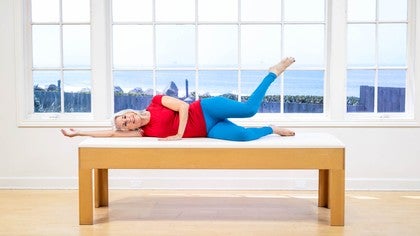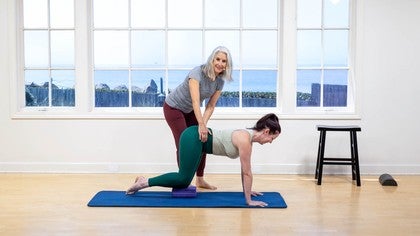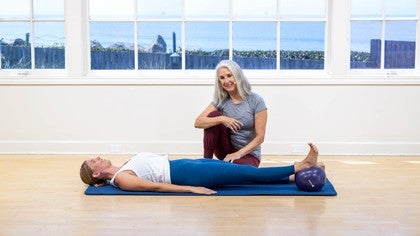Description
About This Video
Transcript
Read Full Transcript
I'm Madeline Black, and I'm gonna offer you some pelvic health tips. First off, your awareness of how you sit and you stand is important to the pelvic health, because people who like to stand in a hip sway, like this, for long periods of time, and only on one side, what's happening here is we're creating a side bending of the spine. We're creating imbalance in the trunk, and over time it's creating a weakness in this hip joint, and the hip joint is directly related to the pelvic diaphragm. So optimally, we wanna feel our weight equal on both legs, but I understand that there's fatigue, and so when we start to get tired we tend to kind of go into this sway position. So if you find yourself standing like this, try to bring yourself onto two feet, or, if you only do one side, go ahead and do it on the other side, as long as you get a little bit of balance here, but the more pressure that we put in the lateral hip here, the more that we're lengthening this part and then it becomes weaker and not able to support.
So your hip joints are directly related to your pelvic diaphragm. Some people stand like this, so when you cross your legs. And I understand this can be comfortable for some, not for me, I don't usually stand like this, but this can be, if I lock my legs, now I don't have to use much in my pelvis or my pelvic diaphragm to stand up. So there's a natural tone and it's kind of adapting to our surfaces and our nervous system that the pelvis does internally for us. So the minute we do a stance where we take out that ability of the tone, then we're losing the support in the pelvis.
So just be aware of how you're standing and catch yourself swaying or crossing your legs. The other place is sitting, since we sit at work and sit at home. When you're sitting, if you're sitting with your legs dangling down, it's a little bit more a pull on the pelvis and your pelvis might fall a little bit forward. So when you're sitting, you could have something under your feet, or make sure your chair is at such a size that your feet are in contact with something. And you're sitting on your pelvic bones at the bottom, they're called ischial tuberosities, and we can rock on them.
And actually rocking is a very nice movement to do to kind of just loosen that up here, and then you want to feel that you're equally weighted on both of those sit bones there. You can think of those sit bones as your feet. So as I showed you standing, if you're on one leg more than the other, you're gonna create an imbalance, same thing as you're sitting on your sit bones, so that you're not sitting on one sit bone more than the other, see if you can notice that you're sitting on two. In addition to the weight shift on your sit bones, if you find yourself sitting with your legs crossed, which many of us do, this also will create an imbalance in the hips just like standing with your legs crossed. So if you find yourself always crossing your right leg over your left leg, try to sit with your left leg over the right so that you're at least getting a little bit more balance between your right and left side.
And ideally is really not crossing your legs when you're sitting, it will really help with your hip joint health. So those are the postures that I would like you to be aware of so that you can optimize your pelvic health. And little easy things to do would be if you had a ball, and it can be smaller than this, and this ball is a air ball that's slightly deflated, is take the opportunity to sit on the ball, right? And so when you're sitting on it, it allows the pelvis to sink and relax that pelvic diaphragm. And it's also kind of nice to also get this little bit of motion.
So the sit bone dropping back and forth is kind of easing up the tissue there, and you can just breathe into the ball. (inhales deeply) Exhale, that helps kind of relax and release the pelvic floor. Now, if you have too much laxity you might be like, "hey, I don't need a release down there." Okay, so if that's the case, then what you can do also on the ball is you can kind of draw the ball in and up inside your pelvis. It's just like you imagine it, and then you relax. So if you can feel the sit bones on the ball, you can just imagine that you're drawing the ball into the pelvis and up into the pelvis, and you can hold it and then relax it down. Also your sacral position, so if you rock on your ball forward and back this way, kind of give you a sense of where your pelvis is, if it's way back towards your tailbone, or is it way forward towards your pubic bone, and you want to just be in the middle of that.
So giving the opportunity for your pelvic diaphragm to have a chance to support the pelvis. Also the thoracic, this area and part of the pelvis. So we have the pelvic diaphragm and we have our breathing diaphragm, and they're very related to one another, they function together. So doing some nice, easy twists while you're sitting periodically to keep the ribs free for breathing will also help with the motion of the pelvic floor. And in a twist, you can actually hold the twist and breathe into the opposite side here, opening those ribs a little bit, and then exhale and come back.
So that feels really good too. So as you twist, you're gonna breathe into the side, (inhales deeply) expanding the ribs, and then come back. So just two or three times periodically throughout the day as you're sitting. Now, side-laying, if you want to get into doing some movement, not like every day situations, but you actually want to get on the floor, hip mobility is very important to that. So one of the things you can do is side lie, and I like to lie on my side with my arm straight out, like this, and you bring your knees and feet together, and the heels back by the sit bones here.
So I rest here. Now this may be uncomfortable for your shoulders, so if you want, you can bring your arm forward, but make sure you have a support for your head, like that. But I like stretching my arm over because it gives me the length on that side. So here. So squeezing the heels together, just squeeze the heels together, keep squeezing the heels as you just lift the knee a small amount.
We're doing external rotation, and then you come back down. So you squeeze the heels, and you're gonna feel the activation through the inner thigh, and then lift the knee up, and down. So heel squeeze and lift, and you don't have to do a lot. If you want to do what's more intense exercise you can do more reps, but doing a lot of this motion can also be a little tightening for the hip. So we're just thinking about mobility here, so just need to do three or four, and then you can lift up and then just rotate your knee inward and outward.
So you can just play around, we want to get that motion, the inward rotation and the outward rotation of the hip. Just super easy like that. And down. So we should do the other side, 'cause you'll feel funny if you only do one side. So stretch your arm out, so we get this length here.
Remember your heels are in line with your tailbone. So the knees aren't up too high. And then you just start by squeezing your feet together, you squeeze your heels and the inner edges of your feet together, and keep squeezing that as you lift the knee, and down. Remember we're going for mobility, we want to be able to get that rotation of the knee three or four times, and then you lift the knee up, keep it there, and then just turn your knee in and touch, or you can touch your toe again, turn the knee in. So we're just trying to get that spiral of the leg, should feel good.
Again, we're not doing any kind of like intense thing here, we're just trying to get some mobility there. Okay, and then come sit up. So we got the mobility, so it's nice and easy mobility of the hip, and now I want to work on lengthening through the spine, but more importantly, the sacral position of the pelvis. So we're gonna lie on our stomach here. And you can fold your hands and place your forehead here, but I'm just gonna turn and look at you and talk a little bit here.
So I want your legs wide and turn them in, let your heels go out. In fact, you can move your heels in and out, check out that hip mobility here, all right, and then swing the heels out. And what that creates is a widening through your sit bones here. So we're gonna have wide sit bones, and then all I want you to do is take a breath in, and as you exhale, imagine your sacrum sinking. Sinking to the bottom, towards your pelvis, into the mat, just sinking down.
And then take a breath in and feel the sacrum float. (inhales deeply) And then as you exhale, (exhales deeply) feel that sacrum sinking down. And then you can also think of the sacrum and then your sternum. So you're gonna inhale, exhale sink, and sternum sink. So gravity, we're kind of kind of coming into the mat, we're letting gravity actually lengthen, and you might find you have to move your arms (inhales deeply) because your spine is lengthening out. (exhales deeply) And that's all that is, it feels really wonderful. And a little more thoracic rotation is with the thread the needle exercise here.
So we're gonna come into a quadruped position here. And very simple, all you have to do is you can just slide your hand and just turn and look, it doesn't have to be a big motion, you can do small, like this, and then slide and just look over your shoulder. Slide, look over your shoulder. That's all it needs to be. And the breathing.
Now, if you want to, you could take it into the full thread the needle, but see, now we're getting into hip joint, which is fine, you get to release your hip. And come back up, and slide and come back up. But even just doing this small motion this way is really nice for lubricating and getting that motion in the thorax. And with these ease of motion, hip joint mobility, thoracic mobility, opening up the sit bones and relaxing, we'll be able to set your pelvic diaphragm in a great place to be for the rest of your day. So thank you.
Pelvic Health: Pelvic Assessments and Tips
Comments
You need to be a subscriber to post a comment.
Please Log In or Create an Account to start your free trial.













